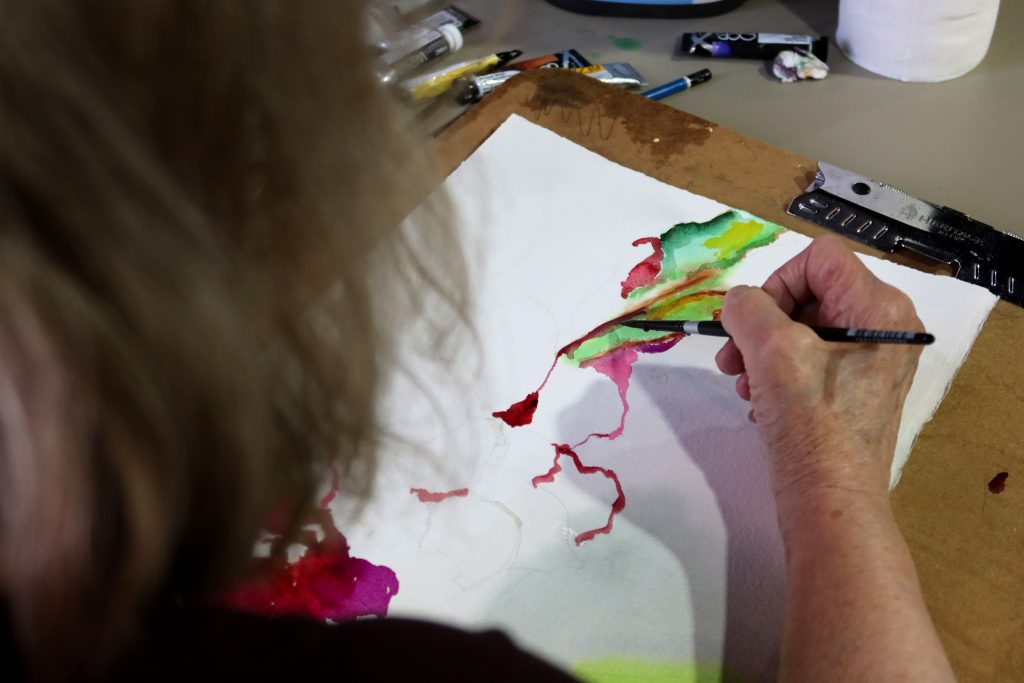
Oct. 11
Let’s get ready for our Holiday Party
This year BWS members are invited to create two items for the holiday party on Monday, Dec. 13. First, you may create one or two watercolor postcards in a design of your choice. Members are also invited to create a “structure” out of watercolor paper. At Monday’s meeting Joanne Weddle will share examples of both cards and structures.
To attend the meeting via Zoom, look for the link in an email from Joanna Samorow-Merzer or from Carol Rhodes.
If you are vaccinated and wearing a mask, you can attend in-person at the First Christian Church’s Great Hall, 205 E. Kirkwood. If attending the meeting in person, dress in layers as windows will be open to facilitate ventilation.
Free parking is available in the IU Poplars Garage on Sixth Street, across from the Runcible Spoon. Pay parking is available on the streets and in the Fourth Street Garage, across from the former Waldron building.
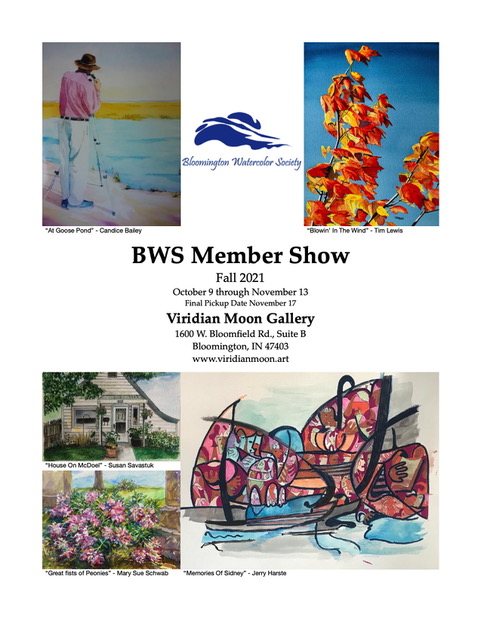
Annual BWS paint-out and picnic
at Switchyard Park shelter
Saturday, Oct. 9
Starting at 10 a.m., Lunch at 12:30 p.m.
Stay as late as you like
Bring art supplies or an art project plus a brown-bag lunch. Paint or sketch this beautiful park and enjoy a picnic lunch with BWS friends. Coffee, iced tea, cups and ice will be provided. This is not a shared lunch because of COVID-19. Sweets or snacks that can be prepared and offered safely would be greatly appreciated.
The main entrance to the park is on Rogers Street between Rockport Road and Grimes Street. The parking lot at the Rogers Street entrance is the closest to the shelter. Restrooms are near the shelter.
Masks are required when not maintaining social distance.
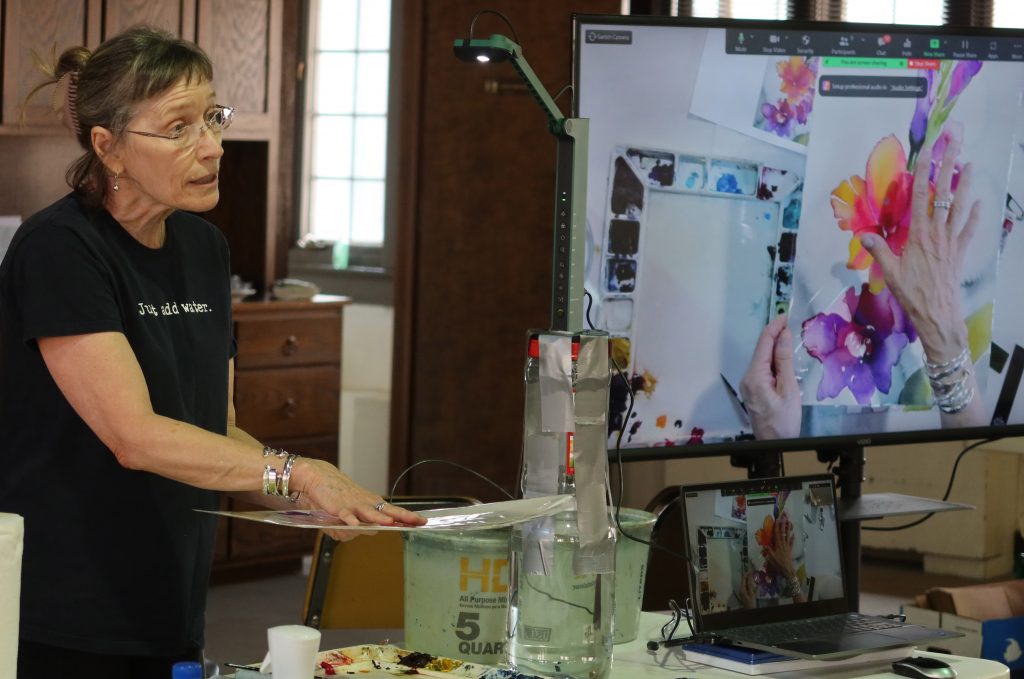
Carol Carter shares her
‘imaginary color’ approach
at BWS fall workshop
by Claude Cookman
The artist swishes her No. 10 brush in a gallon bucket of clean water, leans over the table and saturates a gladiolus petal with the clear liquid. She charges the brush with Alizarin Crimson, touches it to the water, and we watch with her on a large digital screen as the brilliant red explodes — branching out in a thousand bifurcations — across the glistening surface.
Then Carol Carter, the artist, transforms into Carol Carter, the teacher, and 18 of us in the Great Hall of Bloomington’s First Christian Church plus another seven on Zoom follow her as she guides us through painting our own vivid glads.
During a two-day Bloomington Watercolor Society workshop in early September, Carter, an award-winning artist and teacher who lives in St. Louis, shared her process and immersed us in her “imaginary color” approach.
BWS Treasurer Carol Rhodes, who did an immense amount of work coordinating the event, explained why she invited Carter: “Her abstract approach to painting and her deeply saturated, fantastical use of color is unlike any of our recent presenters.”
Carter’s method
Carter describes herself as a cell painter, completing one shape, or cell, at a time. She starts from the back and paints forward, saving the focal point for last. “Think of the paper like a stage,” she says. “You are setting the stage for the main character.”
The text on Carter’s T-shirt read, “Just Add Water,” and she lives up to that motto by resolutely painting wet into wet. “You can never have enough water” is a mantra she repeats frequently. She wets each cell with clear water before adding paint. All mixing is done on the wet paper, never a palette.
She also uses fresh paint. Instead of rewetting cracked, caked pigments in palette wells, she squeezes out a pea-size dab of each color. She likens this to eating fresh, instead of stale, vegetables — the best way to get vibrant color.
Carter calls herself “a one-and-done” painter, meaning she gets the colors, values, and paint density on the first application. She does not add paint after the first round dries, limiting any adjustments to occasionally softening an edge to make a transition between shapes.
The major technical skill she wanted to teach was how to break down a reference photo into a drawing we could paint from. “Reference photos give you every nuance — too much information!” she exclaimed. “Get just the essence.”
She urged us to simplify by omitting unimportant detail and by seeing component shapes instead of subjects. She elaborated with an example from her student days. In a life-drawing class, she was struggling to capture the model’s elbow. After several failed attempts, she had a break-through: Don’t paint the elbow, she realized, paint a beautiful shape. Viewers will figure it out.
Carter’s most distinctive technique put a contour line around most of those shapes. After wetting a cell, she had us paint the edge with a small brush, applying half the paint inside the wet shape and half outside. Using a brush with clear water, we feathered out the paint on the inside and finally painted the shape with a base color, often applying a second color. She painted most of her shapes with thick pigment, created gradients, and in some places feathered lighter densities out to paper white.
Imaginative color
Many of us signed up for Carter’s workshop after seeing her creative approach to color in her online galleries. We were not disappointed.
“Color is a connective voice,” she said in an interview. “Color can win you an audience when an image can’t.
“Don’t use local color,” she insisted. “Get away from brown hair, flesh skin. Change it up a bit. Play with color.”
“Realistic color is: a brown door equals sepia, burnt sienna, and brown pigment,” Carter explained. “But inventive color is: a brown door is a dark value [that] can be a blue, a green, a dark-value purple or even a dark-value red.”
Focusing on value “frees you up to plug in any color,” she continued. “Once you see color as value, you can be inventive with your color choice.”
To see those values, she uses a red glass which filters out color.
She recommends picking “a warm and a cool and maybe a complementary color.” Then, “use color as emotion to dictate the message you are trying to convey,” she said. You can use a hot, fiery palette or a cool, moody palette or even a green face.” She has painted “a lot of green figures in orange pools,” the opposite of naturalistic warmed-toned figures in cool water. “I flipped the sensibility,” she said.
Good advice comes in threes
Carter had three major pieces of advice for BWS members:
- Work every day. “If you want to be a painter, go into the studio six days a week and paint,” she admonished. “On Sunday, look at what you’ve painted.”
2. Push your gift. Art is extremely complex. Not every artist can be good at every aspect, but, “every artist has something that they’re naturally good at,” Carter insisted. “That’s the path you should follow — what you’re good at — and not beat yourself up for what you’re not good at.”
“Early on, I recognized my gift was color,” she said. “So I pushed that as something that would always permeate my growth as an artist. I struggle with value or composition or content. So I explore the color, and the value comes secondarily.”
3. Paint what you love. “At some point you have to let go of the how [technique] and move to the why [motivation],” she told the group. In an interview, she expanded on this from her own artistic trajectory.
“For the first five years of my career, after college and before I went to graduate school [at Washington University in Saint Louis], I struggled with what to paint,” she related. “I was a realistic painter. I was a plein air painter. I did a bunch of different imagery that was polished. But it wasn’t really from the heart.
“At graduate school, they don’t care what you paint, but you have to defend why you painted it,” she continued. “And I realized early on that I was giving no thought to why I was painting. I was just painting what I thought my clientele wanted. It was nothing from within.”
She reset her practice, spending most of her first graduate year painting color abstractions. When a blue shape kept reappearing, a professor asked what it was about. Carter, who grew up in Florida loving swimming pools, realized the abstract shape referenced those pools.
“Why don’t you paint the pool?” the professor asked. For the next year Carter did just that. “It connected to the why I was painting which was autobiographic, narrative, and personal,” she said.
“That launched the rest of my career, which is based around imagery that I feel profoundly connected to as an artist,” she said. “I’m no longer a realistic painter, but I am a representational painter. I’m no longer an abstract painter, but abstraction figures in my work.
“I think too many artists never get to the why of what they’re painting,” she said. “They keep answering the how. You do need how. My work is very how oriented. But it doesn’t just dwell on that. And that does not drive me as an artist. It’s the why.”
She summed it up in a single sentence: “I think the most important thing to learn from me as an artist is to paint what you love.”
Carter explores motifs she loves by working in series. She introduced us to two of them — flowers and horses — in her workshop. During breaks she shared others, including large-scale faces and people in swimming pools. She is currently painting a series of 6- x 6-inch dog portraits. She has completed 100 and intends to add another 20. At that point, she will exhibit them and probably move on to a new subject, perhaps ice in a glass of water which she has started exploring.
Regarding her motivation as a teacher, Carter said, “I feel like my job as an art instructor is to inspire people to take a risk and do something different.”
That “something different” may involve a continuing collaboration between Carter and interested members of BWS. At dinner on Friday, Carter, Carol Rhodes, Jacqueline Fernette, and others connected the idea of painting what you love to the question of how art could make a difference. They hit on the notion of painting subjects that are likely to disappear because of global warming. They plan to invite artists who wish to be involved to engage with Carter in this effort to raise consciousness about the climate change crisis.
Stay tuned to Brushstrokes for developments.
Welcome Connie!
Our roster of new members continues to grow. This month we would like to welcome Connie McIntyre, who brings our roster to a total membership of 80 as of Sept. 30. We look forward to meeting you, Connie!
BWS field trip to the LUME at Newfields



A group of BWS members and friends traveled to Newfields in Indianapolis Sept. 30 for the immersive Van Gogh experience in THE LUME.
NEW!
Show Calendar
As a service to its members, BWS is initiating a show calendar project – a listing of upcoming shows that may be of interest to BWS members. We want our exhibitors to have an easy way to find upcoming opportunities, and we want to encourage those who are less experienced or new to exhibiting.
The show calendar will be updated and sent to you every month as an attachment to the email announcing the publication of Brushstrokes, edited by Nancy Metz and Jerry Harste.
This is a member-driven project. A few people have made initial entries to get the calendar started, but it will be successful only if other members take an active role in keeping the spreadsheet populated with new opportunities.
To add entries to the show calendar: Send a newsletter, a email, a listing on a website, or other resources referencing the show – preferably including a link to the prospectus or the prospectus itself – to showinfo@bloomingtonwatercolor.org; one of our members will extract the information needed and enter it on the spreadsheet.
We would like your input on the calendar itself:
Does it include the information you want and need to make a decision about entering a show?
What show-sponsoring organizations would you like to see listed in addition to BWS? Watercolor Society of Indiana? Upland Plein Air? Indiana Plein Air Painters Association (IPAPA)? Others?
You can download the Excel spreadsheet, save it to your own computer, and modify it however you like to best serve your needs. For example, one member said she was going to add columns so that she could track which artworks she had entered or exhibited at which show. This will not affect the BWS master document.
To enable BWS to best serve its members in this way, please send your feedback and entries to showinfo@bloomingtonwatercolor.org.
Member News

Connie McIntyre shares a recent painting in which she added some wildflowers she grows as a little added factor. “I have so much fun creating these pictures,” she said. “To me it is truly a form of therapy.”
Sandy Hall sent a painting she is exhibiting at Greenfield’s Riley Festival Oct. 7-10. The theme is based on James Whitcomb Riley’s Poem, “The Bumblebee.” Artwork is housed at 2 W. Main St. Sandy also announced publication of Argyle’s New Friend, which features her illustrations, which were done in acrylics. The book is a sequel to MOMMS, the Mountain of Mismatched Socks.



Left to Right: “The Bumblebee” by Sandy Hall, Argyle’s New Friend book cover, “Agapanthus Flowers” by Sandy Hall
Last month Tim Lewis was juried in as a member of the Art IN Hand Gallery in Zionsville. Both of his entries, “Winter Oak” and “Waiting,” were juried into the annual Open Space: Art About The Land exhibit put on by Minnetrista and the Redtail Conservancy. The show will run Oct. 2 through Nov. 7 at the Minnetrista Center in Muncie, from Nov. 17 through Dec. 23 at the Art Association of Henry County in New Castle, and then finish at the Anderson Museum of Art in Anderson from Jan. 12 through Feb. 20. His painting, “Inflation”, will be a part of the Watercolor Society of Indiana exhibit at the Gallery at Fishers City Hall from Nov. 4 – 28.



Counterclockwise from Top Left: “Inflation,” “Winter Oak,” and “Waiting” watercolors by Tim Lewis
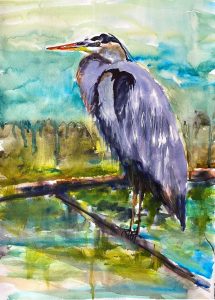
“Head Scout,” a painting by Penny Lulich, made it into the Pittsburgh Watercolor Society Aqueous International Exhibition, which runs through Nov. 30. Carla O’Conner was the juror. Penny writes: “This was my fourth painting to be juried into shows this year, which was completely unexpected as it is my first year to submit to any show outside of BWS member exhibits. I would sure like to encourage others who might be thinking of submitting, to do it. It can definitely be stepping outside of one’s comfort zone (I know it was for me), but the reward of getting an acceptance is worth any discomfort or even a few rejections along the way (yes, I had a few of those as well). If you’d like to visit the show, here is the link: https://www.pittsburghwatercolorsociety.com/page-1735944.”

MarySue Veerkamp-Schwab has been awarded Signature Member status in the Watercolor Society of Indiana.
Lynne Gilliatt reports she is making abstract patterns on hand-dyed rectangles for a Spring show with Jean Haley here in Bloomington. She uses plain embroidery cotton thread and makes the colors pop. She has also been writing essays for The Ryder Magazine. Her third one, called “Cooling Off,” will probably be published in October.

“Citrus Bowl” by Joanna Samorow-Merzer is one of the many watercolors currently on display in the BWS Member Show at Viridian Moon Art Gallery.
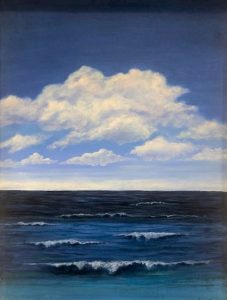
Carolyn Rogers Richard was invited to submit a painting for the Brown County Rotary Club’s annual Taste of Art charity fundraiser auction, which will take place Oct. 15 at 7:15 p.m. at the Seasons Lodge Conference Center, 560 SR 46, Nashville. A silent auction will also be offered 6 to 7 p.m. Details and tickets are available on the Rotary website at rotaryclubofbrowncounty.org. An article will appear in the Oct. 10 Bloomington Herald Times art section.
Calendar
Oct. 9 BWS Paintout and Picnic, 10 a.m./lunch at 12:30 p.m., Switchyard Park shelter
Oct. 9 Member Show Reception, 5-7 p.m., Viridian Moon Art Gallery
Oct. 11 Monthly BWS Meeting, 6 p.m. In person at First Christian Church and via Zoom

